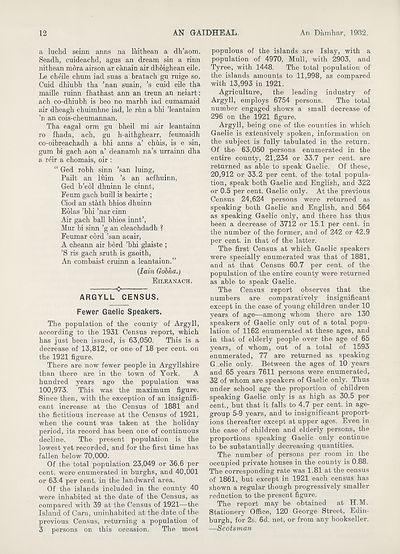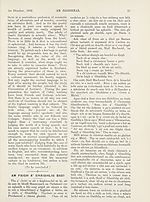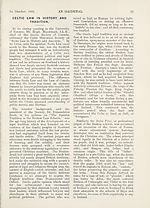An Comunn Gàidhealach Publications > Gaidheal > Volume 28, October 1932--September 1933
(24) Page 12
Download files
Complete book:
Individual page:
Thumbnail gallery: Grid view | List view

12
AN GAIDHEAXi.
An Damhar, 1932.
a luchd seinn anns na laithean a dh’aom.
Seadh, cuideachd, agus an dream sin a rinn
nithean mora airson ar canain air dhoighean eile.
Le cheile chum iad suas a bratach gu ruige so.
Cuid dhiubh tha ’nan suain, ’s cuid eile tha
maille ruinn fhathast ann an treun an neiart:
ach co-dhiubh is beo no marbh iad cumamaid
air dheagh chuimhne iad, le rim a bhi ’leanfcainn
’n an cois-cheumannan.
Tha eagal orm gu bheil mi air leantainn
ro fhada, ach, gu h-aithghearr, feumaidh
co-oibreachadh a bhi anns a’ chuis, is e sin,
gum bi gach aon a’ deanamh na’s urrainn dha
a reir a chomais, oir :
“ Ged robh sinn ’san luing,
Pailt an luim ’s an acfhuinn,
Ged b’eol dhuinn le cinnt,
Feum gach buill is beairte ;
Ciod an stath bhios dhuinn
Eolas ’bhi ’nar cinn
Air gach ball bhios innt’,
Mur bi sinn ’g an cleachdadh ?
Feumar cord ’san acair,
A cheann air bord ’bhi glaiste ;
’S ris gach sruth is gaoith,
An combaist cruinn a leantainn.”
(Iain Gobha.)
Eileanach.
O
ARGYLL CENSUS.
Fewer Gaelic Speakers.
The population of the county of Argyll,
according to the 1931 Census report, which
has just been issued, is 63,050. This is a
decrease of 13,812, or one of 18 per cent, on
the 1921 figure.
There are now fewer people in Argyllshire
than there are in the town of York. A
hundred years ago the population was
100,973. This was the maximum figure.
Since then, with the exception of an insignifi¬
cant increase at the Census of 1881 and
the fictitious increase at the Census of 1921,
when the count was taken at the holiday
period, its record has been one of continuous
decline. The present population is the
lowest yet recorded, and for the first time has
fallen below 70,000.
Of the total population 23,049 or 36.6 per
cent, were enumerated in burghs, and 40,001
or 63.4 per cent, in the landward area.
Of the islands included in the county 40
were inhabited at the date of the Census, as
compared with 39 at the Census of 1921—the
Island of Cara, uninhabited at the date of the
previous Census, returning a population of
3 persons on this occasion. The most
populous of the islands are Islay, with a
population of 4970, Mull, with 2903, and
Tyree, with 1448. The total population of
the islands amounts to 11,998, as compared
with 13,993 in 1921.
Agriculture, the leading industry of
Argyll, employs 6754 persons. The total
number engaged shows a small decrease of
296 on the 1921 figure.
Argyll, being one of the counties in which
Gaelic is extensively spoken, information on
the subject is fully tabulated in the return.
Of the 63,050 persons enumerated in the
entire county, 21,234 or 33.7 per cent, are
returned as able to speak Gaelic. Of these,
20,912 or 33.2 per cent, of the total popula¬
tion, speak both Gaelic and English, and 322
or 0.5 per cent. Gaelic only. At the previous
Census 24,624 persons were returned as
speaking both Gaelic and English, and 564
as speaking Gaelic only, and there has thus
been a decrease of 3712 or 15.1 per cent, in
the number of the former, and of 242 or 42.9
per cent, in that of the latter.
The first Census at which Gaelic speakers
were specially enumerated was that of 1881,
and at that Census 60.7 per cent, of the
population of the entire county were returned
as able to speak Gaelic.
The Census report observes that the
numbers are comparatively insignificant
except in the case of young children under 10
years of age—among whom there are 130
speakers of Gaelic only out of a total popu¬
lation of 1162 enumerated at these ages, and
in that of elderly people over the age of 65
years, of whom, out of a total of 1593
enumerated, 77 are returned as speaking
Gaelic only. Between the ages of 10 years
and 65 years 7611 persons were enumerated,
32 of whom are speakers of Gaelic only. Thus
under school age the proportion of children
speaking Gaelic only is as high as 30.5 per
cent., but that it falls to 4.7 per cent, in age-
group 5-9 years, and to insignificant proport¬
ions thereafter except at upper ages. Even in
the case of children and elderly persons, the
proportions speaking Gaelic only continue
to be substantially decreasing quantities.
The number of persons per room in the
occupied private houses in the county is 0.88.
The corresponding rate was 1.81 at tbe census
of 1861, but except in 1921 each census has
shown a regular though progressively smaller
reduction to the present figure.
The report may be obtained at H.M.
Stationery Office, 120 George Street, Edin¬
burgh, for 2s. 6d. net, or from any bookseller.
—Scotsman
AN GAIDHEAXi.
An Damhar, 1932.
a luchd seinn anns na laithean a dh’aom.
Seadh, cuideachd, agus an dream sin a rinn
nithean mora airson ar canain air dhoighean eile.
Le cheile chum iad suas a bratach gu ruige so.
Cuid dhiubh tha ’nan suain, ’s cuid eile tha
maille ruinn fhathast ann an treun an neiart:
ach co-dhiubh is beo no marbh iad cumamaid
air dheagh chuimhne iad, le rim a bhi ’leanfcainn
’n an cois-cheumannan.
Tha eagal orm gu bheil mi air leantainn
ro fhada, ach, gu h-aithghearr, feumaidh
co-oibreachadh a bhi anns a’ chuis, is e sin,
gum bi gach aon a’ deanamh na’s urrainn dha
a reir a chomais, oir :
“ Ged robh sinn ’san luing,
Pailt an luim ’s an acfhuinn,
Ged b’eol dhuinn le cinnt,
Feum gach buill is beairte ;
Ciod an stath bhios dhuinn
Eolas ’bhi ’nar cinn
Air gach ball bhios innt’,
Mur bi sinn ’g an cleachdadh ?
Feumar cord ’san acair,
A cheann air bord ’bhi glaiste ;
’S ris gach sruth is gaoith,
An combaist cruinn a leantainn.”
(Iain Gobha.)
Eileanach.
O
ARGYLL CENSUS.
Fewer Gaelic Speakers.
The population of the county of Argyll,
according to the 1931 Census report, which
has just been issued, is 63,050. This is a
decrease of 13,812, or one of 18 per cent, on
the 1921 figure.
There are now fewer people in Argyllshire
than there are in the town of York. A
hundred years ago the population was
100,973. This was the maximum figure.
Since then, with the exception of an insignifi¬
cant increase at the Census of 1881 and
the fictitious increase at the Census of 1921,
when the count was taken at the holiday
period, its record has been one of continuous
decline. The present population is the
lowest yet recorded, and for the first time has
fallen below 70,000.
Of the total population 23,049 or 36.6 per
cent, were enumerated in burghs, and 40,001
or 63.4 per cent, in the landward area.
Of the islands included in the county 40
were inhabited at the date of the Census, as
compared with 39 at the Census of 1921—the
Island of Cara, uninhabited at the date of the
previous Census, returning a population of
3 persons on this occasion. The most
populous of the islands are Islay, with a
population of 4970, Mull, with 2903, and
Tyree, with 1448. The total population of
the islands amounts to 11,998, as compared
with 13,993 in 1921.
Agriculture, the leading industry of
Argyll, employs 6754 persons. The total
number engaged shows a small decrease of
296 on the 1921 figure.
Argyll, being one of the counties in which
Gaelic is extensively spoken, information on
the subject is fully tabulated in the return.
Of the 63,050 persons enumerated in the
entire county, 21,234 or 33.7 per cent, are
returned as able to speak Gaelic. Of these,
20,912 or 33.2 per cent, of the total popula¬
tion, speak both Gaelic and English, and 322
or 0.5 per cent. Gaelic only. At the previous
Census 24,624 persons were returned as
speaking both Gaelic and English, and 564
as speaking Gaelic only, and there has thus
been a decrease of 3712 or 15.1 per cent, in
the number of the former, and of 242 or 42.9
per cent, in that of the latter.
The first Census at which Gaelic speakers
were specially enumerated was that of 1881,
and at that Census 60.7 per cent, of the
population of the entire county were returned
as able to speak Gaelic.
The Census report observes that the
numbers are comparatively insignificant
except in the case of young children under 10
years of age—among whom there are 130
speakers of Gaelic only out of a total popu¬
lation of 1162 enumerated at these ages, and
in that of elderly people over the age of 65
years, of whom, out of a total of 1593
enumerated, 77 are returned as speaking
Gaelic only. Between the ages of 10 years
and 65 years 7611 persons were enumerated,
32 of whom are speakers of Gaelic only. Thus
under school age the proportion of children
speaking Gaelic only is as high as 30.5 per
cent., but that it falls to 4.7 per cent, in age-
group 5-9 years, and to insignificant proport¬
ions thereafter except at upper ages. Even in
the case of children and elderly persons, the
proportions speaking Gaelic only continue
to be substantially decreasing quantities.
The number of persons per room in the
occupied private houses in the county is 0.88.
The corresponding rate was 1.81 at tbe census
of 1861, but except in 1921 each census has
shown a regular though progressively smaller
reduction to the present figure.
The report may be obtained at H.M.
Stationery Office, 120 George Street, Edin¬
burgh, for 2s. 6d. net, or from any bookseller.
—Scotsman
Set display mode to:
![]() Universal Viewer |
Universal Viewer | ![]() Mirador |
Large image | Transcription
Mirador |
Large image | Transcription
| An Comunn Gàidhealach > An Comunn Gàidhealach Publications > Gaidheal > Volume 28, October 1932--September 1933 > (24) Page 12 |
|---|
| Permanent URL | https://digital.nls.uk/127131300 |
|---|
| Description | This contains items published by An Comunn, which are not specifically Mòd-related. It includes journals, annual reports and corporate documents, policy statements, educational resources and published plays and literature. It is arranged alphabetically by title. |
|---|
| Description | A collection of over 400 items published by An Comunn Gàidhealach, the organisation which promotes Gaelic language and culture and organises the Royal National Mòd. Dating from 1891 up to the present day, the collection includes journals and newspapers, annual reports, educational materials, national Mòd programmes, published Mòd literature and music. |
|---|---|
| Additional NLS resources: |
|

